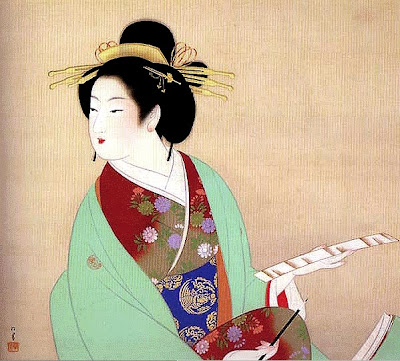Borëd Artist Spotlight | Shoen Uemura
- Bored B.B

- Nov 3, 2021
- 2 min read

The revolutionary Japanese painter Uemura Shōen was a Taurus born on April 23, 1875 in Kyoto, Japan. She was born two months after the death of her father, and was raised by her mother and her aunts. Her mother ran a tea shop and Shōen would sit in the corner drawing while she tended to customers who were later fans of her art. At this time, the only way a woman could advance her art skills beyond a hobby was if she had an artistic family member who could train her in her own home, as was the case with the renowned female painter Kiyohara Yukinobu.
A diligent woman herself, Shōen’s mother supported her daughter's decision to pursue a career in painting and sent her to the Kyoto Prefectural Painting School when she was 12. Here she began studying under the Chinese-style landscape painter Suzuki Shōnen, who rewarded her talents by giving her the first kanji (Chinese characters that are used in the Japanese writing system) of his pseudonym (Shō) to use in hers. He also let her pursue figure painting, even though this wasn’t permitted by the school until the later years of training. But, Like all great geniuses, she left without graduation.
Shōen (born Uemura Tsune) was one of the first women to start changing this mentality and went on to become one of Japan’s most renowned female artists, reaching a level of recognition that was previously unheard of. At the time when Shōen was raised, it was unusual for a woman to become a professional painter because no women would ever receive professional training at an established school.
Shōen’s appreciation for ukiyo-e, Japanese woodblock print, influenced her style as she developed new techniques and drew a range of subjects. She became most famous for her paintings of female figures, known as bijin-ga. Her tireless study of the world of bijinga (pictures of beautiful women) greatly influenced her artistic output, inspiring her to create images that would catalyze a new evolution in bijinga painting. Thematically, Uemura’s work focused on motifs common to classic bijinga, like beautiful women and iconic figures from noh theater, but with a feminist slant: she had women recreate noh poses in roles typically reserved for men.
During the 1930s, when Shōen was in her late 50s and early 60s, she began producing very large works. Those works included "Spring and Autumn" (1930), "Jo-no-mai" (1936), and "Soshi-arai Komachi" (1937). Many of those works, especially "Jo-no-mai" are now considered her greatest masterpieces.
She broke boundaries, worked tirelessly, and accomplished some incredible firsts, possessing the same quiet but determined will of the women she depicted in her paintings. She made a major contribution to modern art in Japan and paved the way for future women artists. Her autobiography, which is yet to be translated to English, is called Siebishi sono go. She died in 1949, a year after becoming the first woman to win the Order of Culture, proving that painting could be far more than a hobby.
Come back next week to see the next artist in the spotlight!
Want your art featured?
Stay Bored 🖤



















Comments